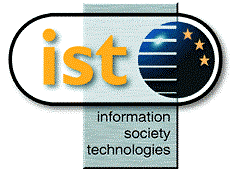(IST)

GCAP
Global Communication Architecture and Protocolsfor new QoS services over IPv6 networks
High performance networking with guaranteed Quality of Service is one of the major challenges of the next decade. It mandates very important efforts to provide multimedia and multicast communications to wide area advanced users, because the limited mechanisms of UDP and TCP cannot adequately support innovant distributed applications. Furthermore, future architectures will involve heterogeneous networks, as new satellite and terrestrial networks having sophisticated intelligent services.
As a consequence, GCAP aims at developing for the future Internet two new end-to-end multicast and multimedia transport protocols, embedded in a new global architecture to provide a guaranteed QoS to advanced Multimedia Multipeer Multinetwork applications.
In order to rapidly experiment the proposed solutions, an efficient deployment of the communication software will be developed over an industrial IPv6 layer by using a programmable active network based technology.
Participant name
1.Centre National de la Recherche Scientifique – Laboratoire LAAS
2.Telebit Communication A/S
3.THOMSON-DETEXIS
4.GMD – Forschungszentrum Informationstechnick GmbH
5.Université P.&M. Curie – Laboratoire LIP6
6.University of Lancaster
7.Universidad Carlos III de Madrid
8.ALCATEL SPACE Industries
9.Telekom Austria
The objectives of the project are:
- to define and evaluate a new end-to-end multicast transport protocol
and a new end-to-end multimedia multicast transport protocol for supporting
dedicated or specialised applications having guaranteed QoS requirements;
- to define and evaluate a new integrated global multinetwork end-to-end
architecture for supporting innovative multimedia and cooperative applications
needing guaranteed Quality of Service;
- to propose a design approach to rapidly deploy and use such new protocols,
that will be developed on top of the new QoS architecture based on IPv6
and DiffServ, by means of an active network based technology;
- to illustrate the feasability and evaluate the potential of the advocated
approach by conducting two experiments using the national research networks
and their European interconnection.
Description of work :
To design and implement a new Transport layer for the Internet next
generation, the work conducted in GCAP will address the following items:
- specify and implement two protocols, designed as two building blocks,
a multimedia protocol and a multicast protocol. These protocols will have
different capabilities in terms of QoS, i.e. of reliability and synchronisation.
They will be consistent with the IETF and the IRTF to which we will participate;
- the multicast protocol will allow the management of groups of users,
and will provide the mechanisms needed to guarantee the selected QoS parameters
to the groups of users ; the multimedia multicast protocol will be made
flexible by defining a set of parameters allowing the application user
to select the monomedia reliability and the multimedia synchronisation
that will be enforced by the layer;
- select an active network approach to be able to run the two previous
protocols written in Java in IPv6 environments. The aim is to produce a
software environment that will be able to support the automatic remote
loading and the automatic remote execution of these two protocols for deployment;
- integrate these results into a new advanced end-to-end multinetwork
transport layer. For this, GCAP will: first carefully analyse the QoS parameters
defining the different interconnected networks; second define the mapping
of the designed protocols to the DiffServ services of the IP layer; third
define a Transport API, extending and compatible with TCP and UDP;
- implement the two protocols. Two demonstrations will be provided:
one on the multimedia mechanisms and one on the multicast service. They
will be conducted on an European testbed using the corresponding national
research networks and their European interconnection;
- evaluate and analyse the results obtained : the protocols themselves
and their mechanisms, the active support environment including code design
and execution, and the large scale deployment and behaviour.
Milestones and expected results :
The main milestones will be :
- the specification and the implementation of the multicast and of
the multimedia protocols,
- the design and implementation of the active network support on top
of IPv6,
- the integration of the running support with the implemented protocols,
- the global architecture of the end-to-end layer,
- the experimental results and lessons derived from the GCAP approach.